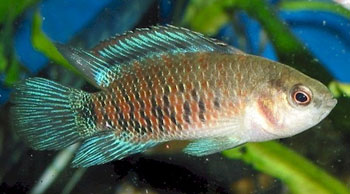The Nandids differ from their related families mainly in skeleton formation. Usually they’ve big mouths capable of opening out to a fairly fantastic extent. The majority of Nandids also have nearly transparent caudal fins, and clear parts in the rear of their anal and dorsal fins. Nandids are widely distributed.
Strangely, the Badis badis is a Nandid that has neither the transparent finnage nor the elastic mouth: it is nevertheless an interesting fish. Fully grown specimens attain a length of 2-3 inch The male is generally longer, but this isn’t a dependable indication of sex, neither is the colouring. Nevertheless, the males do tend to turn out to be much more intense and darker when in breeding condition, whilst the females remain regular. It is rather challenging to describe the colouring of these fish as it varies so a lot with temperament. It can vary between a light red to a dark scarlet, blue and deep mauve. A dark bar runs via the eye. The causes of colour variation are many-the presence of other fish, fright, and water conditions for instance.
An additional characteristic of Badis badis is the hollow underparts which give the impression of wasting. It also adopts unusual positions in the water and when it is immobile it doesn’t seem to mind its body being at any angle.
The Badis badis is rather a peaceful fish and is actually shy despite its rather pugnacious appearance. It prefers to hide away among the plants during the day and truly becomes active at dusk.
Adult females are fuller bodied than the male, which retains the hollow under parts. These fish prefer live foods which should be usually supplied; dried foods other than in small quantities aren’t advisable.
For breeding, the temperature should be raised to 80 F, along with a clean flower pot should be laid horizontally on the floor of the aquarium. The eggs are laid on the inside of the upper surface. The female should be removed instantly after spawning. The male will then tend the eggs by fanning them until the young hatch, which is between 60 and 72 hours. When the young turn out to be totally free swimmers, the male should also be removed.

